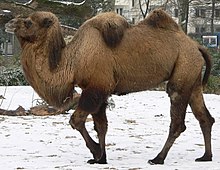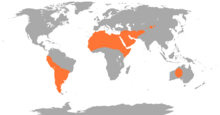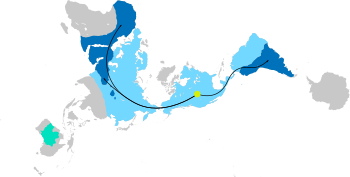Camelidae
| Camelidae | |
|---|---|

| |
| A Bactrian camel walking in the snow | |
| Scientific classification | |
| Domain: | Eukaryota |
| Kingdom: | Animalia |
| Phylum: | Chordata |
| Class: | Mammalia |
| Order: | Artiodactyla |
| Suborder: | Tylopoda |
| Superfamily: | Cameloidea |
| Family: | Camelidae Gray, 1821 |
| Type genus | |
Camelus | |
| Subfamilies | |
| |

| |
| Current range of camelids, all species | |
Camelids are members of the biological
.Characteristics

Camelids are large, strictly
Camelids do not have hooves; rather, they have two-toed feet with toenails and soft foot pads (
Camelids are behaviorally similar in many ways, including their walking gait, in which both legs on the same side are moved simultaneously. While running, camelids engage a unique "running pace gait" in which limbs on the same side move in the same pattern they walk, with both left legs moving and then both right, which ensures that the fore and hind limb will not collide while in fast motion. During this motion, all four limbs momentarily are off the ground at the same time.[7] Consequently, camelids large enough for human beings to ride have a typical swaying motion.
Dromedary camels, bactrian camels, llamas, and alpacas are all induced ovulators.[8]
The three Afro-Asian camel species have developed extensive adaptations to their lives in harsh, near-waterless environments. Wild populations of the Bactrian camel are even able to drink brackish water, and some herds live in nuclear test areas.[9]
Comparative table of the seven extant species in the family Camelidae:
| Species | Image | Natural range | Weight | ||||||
|---|---|---|---|---|---|---|---|---|---|
| Camelus | |||||||||
| Bactrian camel
(Camelus bactrianus) |

|
Central and Inner Asia (entirely domesticated) |
300 to 1,000 kg (660 to 2,200 lb) | ||||||
| Dromedary or Arabian camel (Camelus dromedarius) |

|
South Asia and Middle East (entirely domesticated) |
300 to 600 kg (660 to 1,320 lb) | ||||||
| Wild Bactrian camel
(Camelus ferus) |

|
China and Mongolia | 300 to 820 kg (660 to 1,800 lb) | ||||||
| Lama | |||||||||
| Llama
(Lama glama) |

|
(domestic form of guanaco) | 130 to 200 kg (290 to 440 lb) | ||||||
| Guanaco
(Lama guanicoe) |

|
South America | about 90 to 120 kg (200 to 260 lb) | ||||||
| Alpaca
(Lama pacos) |

|
(domestic form of vicuña) | 48 to 84 kg (106 to 185 lb) | ||||||
| Vicuña
(Lama vicugna) |

|
South American Andes | 35 to 65 kg (77 to 143 lb) | ||||||
Evolution
| A family tree indicating different species within the Camelidae family[10] |

Camelids are unusual in that their modern distribution is almost the inverse of their area of origin. Camelids first appeared very early in the evolution of the even-toed ungulates, around 50 to 40 million years ago during the middle Eocene,[citation needed] in present-day North America. Among the earliest camelids was the rabbit-sized Protylopus, which still had four toes on each foot. By the late Eocene, around 35 million years ago, camelids such as Poebrotherium had lost the two lateral toes, and were about the size of a modern goat.[6][11]
The family diversified and prospered, with the two living tribes, the
The original camelids of North America remained common until the quite recent geological past, but then disappeared, possibly as a result of hunting or habitat alterations by the earliest human settlers, and possibly as a result of changing environmental conditions after the last ice age, or a combination of these factors. Three species groups survived - the dromedary of northern Africa and southwest Asia; the Bactrian camel of central Asia; and the South American group, which has now diverged into a range of forms that are closely related, but usually classified as four species - llamas, alpacas, guanacos, and vicuñas. Camelids were domesticated by early Andean peoples,[12] and remain in use today.
Fossil camelids show a wider variety than their modern counterparts. One North American genus, Titanotylopus, stood 3.5 m at the shoulder, compared with about 2.0 m for the largest modern camelids. Other extinct camelids included small, gazelle-like animals, such as Stenomylus. Finally, a number of very tall, giraffe-like camelids were adapted to feeding on leaves from high trees, including such genera as Aepycamelus and Oxydactylus.[6]
Whether the wild Bactrian camel (Camelus ferus) is a distinct species or a subspecies (C. bactrianus ferus) is still debated.[13][14] The divergence date is 0.7 million years ago, long before the start of domestication.[14]
Scientific classification

Family Camelidae
- †Subfamily Poebrotheriinae
- †Subfamily Miolabinae
- †Subfamily Stenomylinae
- †Subfamily Floridatragulinae
- Subfamily Camelinae
- Tribe Lamini
- Genus: Lama
- Genus: Hemiauchenia
- Genus Palaeolama
- †Palaeolama mirifica
- †
- Tribe Camelini
- Genus: Camelus
- Bactrian camel, Camelus bactrianus
- Dromedary, Camelus dromedarius
- Wild Bactrian camel, Camelus ferus
- †Camelus moreli
- †Camelus sivalensis
- †Camelus knoblochi
- Genus: Camelops
- †Camelops hesternus
- †
- Genus: Paracamelus
- Genus: Camelus
- Tribe Lamini
Phylogeny
| Camelid ancestor |
| |||||||||||||||||||||||||||||||||||||||||||||||||||||||
Extinct genera
| Genus name | Epoch | Remarks |
|---|---|---|
| Aepycamelus | Miocene | Tall, s-shaped neck, true padded camel feet |
| Aguascalientia[24] | Earliest Miocene | A small, primitive, narrow-snouted floridatraguline camel |
| Camelops | Pliocene-Pleistocene | Large, with true camel feet, hump status uncertain |
| Eulamaops | Pleistocene | From South America |
| Floridatragulus | Early Miocene | An unusual species of camel with a long snout |
| Hemiauchenia | Miocene-Pleistocene | A North and South American lamine genus |
| Megacamelus | Miocene-Pleistocene | The largest species of camelid |
| Megatylopus | Miocene-Early Pleistocene | Large camelid from North America |
| Oxydactylus | Early Miocene | The earliest member of the "giraffe camel" family |
| Palaeolama | Pleistocene | A North and South American lamine genus |
| Poebrotherium | Oligocene | This species of camel took the place of deer and antelope in the White River Badlands. |
| Procamelus | Miocene | Ancestor of extinct Titanolypus and modern Camelus |
| Protylopus | Late Eocene | Earliest member of the camelids |
| Stenomylus | Early Miocene | Small, gazelle-like camel that lived in large herds on the Great Plains |
| Stevenscamelus[24] | Late Eocene | Long-snouted primitive relative of Floridatragulus |
| Titanotylopus | Miocene-Pleistocene | Tall, humped, true camel feet |
References
- ^ ISBN 978-0-521-34697-9.
- ^ a b Fowler, M.E. (2010). Medicine and Surgery of Camelids, Ames, Iowa: Wiley-Blackwell. Chapter 1 "General Biology and Evolution" addresses the fact that camelids (including camels and llamas) are not ruminants, pseudo-ruminants, or modified ruminants.
- ISBN 978-0-323-91015-6, retrieved 2023-10-29
- ISBN 978-0-87196-871-5.
- PMID 32123239.
- ^ ISBN 978-0-8160-1194-0.
- S2CID 86174860.
- PMID 3900379. Retrieved September 12, 2014.
- ^ Wild Bactrian Camels Critically Endangered, Group Says National Geographic, 3 December 2002
- ^ "Animal Diversity Web." ADW: Camelidae: CLASSIFICATION. N.p., n.d. Web. 09 June 2017.
- ISBN 978-1-84028-152-1.
- ISBN 978-0-8263-5702-1.
- PMID 17640355.
- ^ PMID 19292708.
- ^ Paleobiology Database - Hemiauchenia basic info
- ^ Paleobiology Database - Palaeolama basic info
- ^ Paleobiology Database - Blancocamelus basic info
- ^ Paleobiology Database - Pleiolama basic info
- ^ Paleobiology Database - Camelops basic info
- ^ Paleobiology Database - Paracamelus basic info
- ISSN 0567-7920.
- ^ Database - Procamelus basic info
- ^ Database - Hesperocamelus basic info
- ^ a b Prothero, D.R.; Beatty, B.L.; Marriott, K. (September 2023). "Systematics of the long-nosed Floridatraguline camels (Artiodactyla: Camelidae)" (PDF). Fossil Record. 9 (94): 533–545. Retrieved 18 December 2023.
